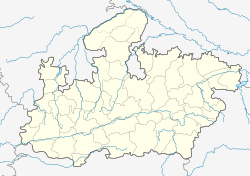Narwar
This article needs additional citations for verification. (October 2014) |
Narwar | |
|---|---|
Town | |
| Nickname: नलपुर | |
| Coordinates: 25°19′N 77°58′E / 25.32°N 77.97°ECoordinates: 25°19′N 77°58′E / 25.32°N 77.97°E | |
| Country | |
| State | Madhya Pradesh |
| District | Shivpuri |
| Population (2011) | |
| • Total | 19,400 |
| Languages | |
| • Official | Hindi |
| Time zone | UTC+5:30 (IST) |
| PIN | 473880 |
Narwar is a town and a nagar panchayat in Shivpuri district in the Indian state of Madhya Pradesh. Narwar is a historic town and the Narwar Fort is just east of the Kali Sindh River and is situated at a distance of 42 km from Shivpuri. Narwar was known as Narwar District during the times of Gwalior State. It is mentioned as Nalpura (Nala's town) in many medieval Sanskrit inscriptions. The Narwar Fort is surrounded by the Kali Sindh River. There are three dams, Harsi Dam, Mohini Sagar and Atal Sagar. Presently the Fort is being renovated by the Archaeological Survey of India.
Legends[edit]
Narwar is identified with Nalapura town mentioned in the Naishadha Charita written by Shriharsha. Nalapura was the capital of Raja Nala of Naisadha, whose love for Damayanti has been mentioned in detail in Mahabharata. When Raja Nala left Damayanti asleep in the forests of Narwar she moved through dense forests and reached Chanderi protecting herself from wild animals.[1][2]:136
History[edit]
The relatively shorter route through forests from Narwar to Chanderi is 200 km. A medieval fortress there was occupied by the Narwarias of the Chambal valley, who were also the founder and rulers of Gwalior, until it was captured by Rajputs in the 12th century. During the 13th century, the Yajvapala dynasty established its capital at Narwar.[3]
On 12 August 1602, Abu'l-Fazl ibn Mubarak, Akbar's courtier who also wrote Akbarnama was assassinated at Narwar while he was returning from the Deccan by Vir Singh Bundela (who later became the ruler of Orchha) between Sarai Vir and Antri (near Narwar) in a plot contrived by Akbar's eldest son Prince Salim (who later became the Emperor Jahangir),[4] because Abu'l Fazl was known to oppose the accession of Prince Salim to the throne. His severed head was sent to Salim at Allahabad. Abu'l Fazl was buried at Antri.[5][6] Abu'l Fazl's son Shaikh Afzal Khan (29 December 1571 – 1613) was later appointed governor of Bihar in 1608 by Jahangir.[7]
In January 1859, Man Singh, raja of Narwar came across Maratha General Tatya Tope who had escaped alone into the jungles of Paron after being defeated by the British. Tatya befriended Man Singh and decided to stay with him. Man Singh was in dispute with the Maharaja of Gwalior. British successfully negotiated with Man Singh to surrender Tatya to them in return for Man safety of Man Singh's life and protection of his family from any reprisals by the Maharaja of Gwalior. After this Tope was alone.[8] The British forces had failed to subdue him for over a year. Tope was betrayed into the hands of the British by his trusted friend, Man Singh, while asleep in his camp in the Paron forest. He was captured on 7 April 1859 by a detachment of native infantry from British General Richard John Meade's troops led to him by Man Singh and escorted to Shivpuri where he was tried by a military court.
Geography[edit]
Narwar is located at 25°19′N 77°58′E / 25.32°N 77.97°E.It has an average elevation of 452 metres (1482 feet).
Demographics[edit]
As of 2001[update] India census,[9] Narwar had a population of 15,748. Males constitute 53% of the population and females 47%. Narwar has an average literacy rate of 58%, lower than the national average of 59.5%: male literacy is 69%, and female literacy is 45%. In Narwar, 18% of the population is under 6 years of age.
References[edit]
- ↑ The Indian Encyclopaedia. Genesis Publishing. p. 5079.
- ↑ C.Kunhan Raja. Survey of Sanskrit Literature. Bharatiya Vidya Bhavan. pp. 136, 146–148.
- ↑ Om Prakash Misra (2003). Archaeological Excavations in Central India: Madhya Pradesh and Chhattisgarh. Mittal Publications. p. 16. ISBN 978-81-7099-874-7.
- ↑ Orchha Archived 7 February 2009 at the Wayback Machine British Library.
- ↑ Majumdar, R.C. (2007). The Mughul Empire, Mumbai: Bharatiya Vidya Bhavan, p. 167
- ↑ Blochmann, H. (tr.) (1927, reprint 1993) The Ain-I Akbari by Abu'l-Fazl Allami, Vol.I, The Asiatic Society, Calcutta, pp. lxviii–lxix
- ↑ Blochmann, H. (tr.) (1927, reprint 1993) The Ain-I Akbari by Abu'l-Fazl Allami, Vol.I, The Asiatic Society, Calcutta, pp. lviii–lix
- ↑ Edwardes, Michael (1975) Red Year. London: Sphere Books; pp. 129-35
- ↑ "Census of India 2001: Data from the 2001 Census, including cities, villages and towns (Provisional)". Census Commission of India. Archived from the original on 16 June 2004. Retrieved 1 November 2008.
